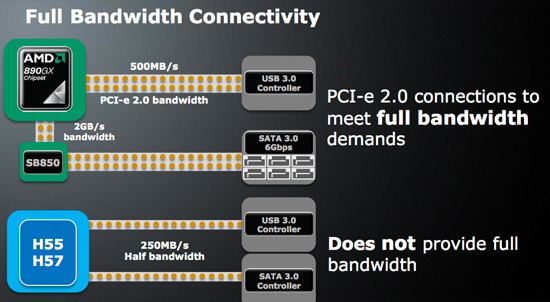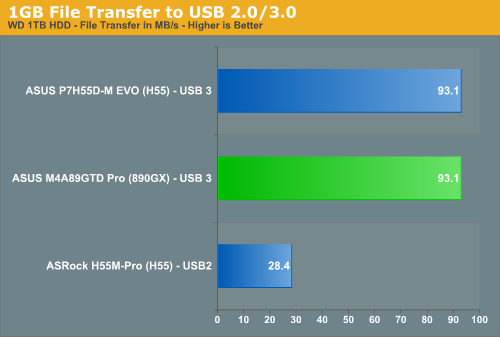AMD's 890GX Chipset - Same Graphics, Better South Bridge
by Anand Lal Shimpi on March 2, 2010 4:36 AM EST- Posted in
- CPUs
Better Suited for USB 3.0?
A little known fact is that Intel’s P55/H55/H57 chipsets run their PCIe lanes at 2.5GT/s. Meaning that a PCIe x1 lane off the chipset only offers 250MB/s in each direction. Aggregate bandwidth is 500MB/s, but that’s only attained if you’re reading at 250MB/s and writing at 250MB/s.

AMD runs all of its PCIe lanes at 5.0GT/s, so a single PCIe x1 slot offers 500MB/s up and 500MB/s down.
Neither AMD nor Intel have integrated USB 3.0 controllers, so they must rely on NEC’s PCIe-to-USB3 controller. AMD’s 890GX chipset offers roughly twice the bandwidth between the chipset and the USB 3 controller.
Today that doesn’t amount to anything. No currently available USB 3.0 peripheral can saturate PCIe 1.0 speeds, but down the road AMD’s approach will avoid any bottlenecks. I’d expect this to start being a problem towards the end of 2010 and into 2011 as we start getting more ONFI 2.0 NAND equipped SSDs that can boast 300MB/s+ read speeds.
USB Performance
No chipset launch article is complete without a never-before-seen problem and we think we hit our quota. We stumbled across an issue using Sharkoon’s USB QuickPort and our ASUS M4A89GTD Pro motherboard; hot-plugging the device into a USB 2.0 port results in a system crash whether you’re in the OS, during POST or within BIOS. The USB 3.0 ports will occasionally work with the drive and we did manage to scramble a quick test (see the graph at the bottom of the page), although the symptoms are largely the same (system hangs, loss of display).
Now, the Sharkoon QuickPort comes with its own power adapter (which it needs to work) and is fully USB 2.0/3.0 compatible, so it should not draw excessive current from the USB ports. There’s always the chance that we’ve got a faulty unit, but bear in mind that it works perfectly with nine motherboards featuring various chipsets.
One thing we noticed is that the M4A89GTD Pro seems to cut power to other USB devices briefly when plug we plug the QuickPort cable into a socket. We tried plugging the drive in while the motherboard is powered down, doing so does allow it to post and enter the OS. After that, Windows finds our USB hard drive and proceeds to load drivers. Trouble is that the drive is not displayed in the ‘My Computer’ menu, and trying to access the drive via the Disk Management snap-in does not work either; we’re continually greeted with a refresh error.
We’re leaning towards the notion of a faulty motherboard at present. ASUS have been notified and have dispatched a new board which should arrive with us shortly. In the meantime, all we’ve got to show for our efforts is 1GB file transfer time over the AMD SB850 vs. Intel’s H55/H57 to the NEC D720200F1 USB 3.0 port using a couple of 1TB Western Digital Caviar hard drives. We know it’s far from an ideal test but will have to suffice for today - sorry folks!

There’s little to divide the boards in a one 1GB file transfer using the SATA HDD’s, it’s obvious that the drives are a bottleneck. We’re aiming to put a couple of 6G SATA drives through their paces on these boards in the near future so we get a better idea of what USB 3 technology can do.










65 Comments
View All Comments
Paladin1211 - Tuesday, March 2, 2010 - link
TechReport has pointed out the 890GX has very good overclock capabilities. I want to know if it can really get the Athlon II X4 630 to over 4Ghz. You have been praising the overclocking potential of the Core i3/i5 + H55/57 all lately. How about the same test with a few sensible AMD CPUs?Thank you.
Reference link:
http://techreport.com/articles.x/18539/10">http://techreport.com/articles.x/18539/10
Rajinder Gill - Wednesday, March 3, 2010 - link
Hi,From the looks of it, those were simply bus frequency tests made possible by a low CPU multiplier. I doubt that CPU's are hitting higher overall core frequencies (at normal CPU multiplier ratios) just by a change of Southbridge.
regards
Raja
Paladin1211 - Wednesday, March 3, 2010 - link
Wasn't it a change of southbridge that "Enabled higher Phenom overclocks?"http://www.anandtech.com/cpuchipsets/showdoc.aspx?...">http://www.anandtech.com/cpuchipsets/showdoc.aspx?...
Rajinder Gill - Wednesday, March 3, 2010 - link
I'd have thought once you get to 4GHz or so most people are limited by cooling because the AMD substrate seems to favour lower temperatures for outright CPU frequency.We can test it against 790 at some point (assuming both boards have been 'engineered' to the same level).
later
Raja
Paladin1211 - Wednesday, March 3, 2010 - link
Waiting for boards, BIOSes, drivers to be more mature is always a good idea. I do care about 24/7 stable overclocking at stock voltage and highest possible core speed on air.Thank you, I'll stay tuned :)
Rajinder Gill - Wednesday, March 3, 2010 - link
Hi,Waiting for things to mature would be a good idea based upon what I'm seeing with the Sharkoon Drive Port..
regards
Raja
chucky2 - Tuesday, March 2, 2010 - link
What was the point of this release, other than to come out with a "new" product to increase sales from the Gotta Have It crowd...?1. STILL no 8 channel over HDMI???? It's something that should have been done in 780G, then 790GX, then 785G, and now 890GX does not support it?!?!?! I don't need to buy an add-in card AMD, I can just buy an Intel box. Insanity.
2. Would it seriously have been so hard to put in a 5000 series core to one-up Intel and actually have SOME reason to buy this over cheaper - and essentially just as good - mature 790GX alternatives (which can also still do core unlocking btw)? Exactly why buy this over a cheaper, more stable 790GX, or competing Intel product?
They should have called this 795GX and saved themselves the embarrassment. <- 690G and 790GX user, not an Intel fanboi.
Chuck
leexgx - Wednesday, March 3, 2010 - link
the audio is very good point, it still can unlock cores and do ACCgeok1ng - Tuesday, March 2, 2010 - link
I once again request a side by side image quality comparison.AT is almost making me concede that Intel graphics are good enough, now all the matter is to proof once and for all that Intel is not cheating ( again, i would kindly remember)on image quality, as it did on the past.
swaaye - Tuesday, March 2, 2010 - link
I'm guessing that one big reason for the IGP being the same is that the bandwidth to RAM, across the HT bus, is unchanged since Phenom came out. The peak bandwidth is a measly 8.8GB/s assuming you have a CPU with a 2.2GHz HT clock, and that is shared with the rest of data going across HT.